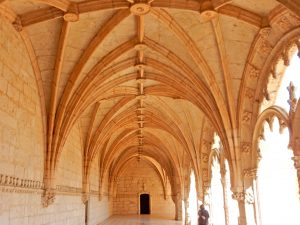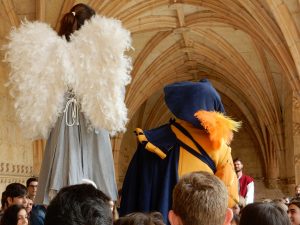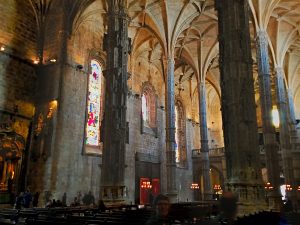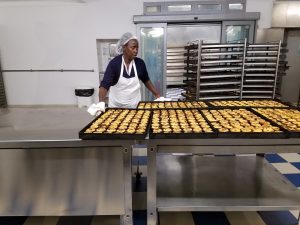On our last day in Lisbon we went to Belém to visit the Jerónimos Monastery. Belém is a parish (district) of Lisbon. In Portugal’s great days of exploration, ships left from directly in front of what is now the monastery.
We had been to the area before but had never been in the monastery because the crowds at the entrance were discouraging. This time, we only had to wait a few minutes to get a ticket and enter. And it was well worth the wait.
Manuel I, the king of Spain from 1495 to 1521, sponsored the building of the monastery in part to make sure there would be monks to pray for him and his family. The monastery and church were paid for by a tax on the importation of spices other than pepper and cinnamon.
The monastery is decorated in Manueline style. That means depictions of ropes, navigation instruments, and religious icons. As you will see in the pictures, the designers/architects made all of these elements work well together.
We spent quite some time in the monastery itself walking around the upper level and looking down at the courtyard of the cloister. I went into an exhibit that had a long timeline of the monastery combined with a timeline of Portugal and a timeline of the world. It was pretty interesting but my brain ran out of processing power in about 1910–which is when the first electric power plant opened in Lisbon.
When I came out of the exhibit I found Patricia watching a “play” put on by people in medieval costumes. There was no stage, so they constantly changed the “setting” by moving stepladders of various sizes around and climbing up and down. The play was in Portuguese, so we could understand not a word. But it was not absolutely necessary to understand the words because the play was very broad and gestures and expressions carried the story. There was an earthy, not ethereal, angel, lawyers, men dressed up as women, a fool, a shoemaker, a farmer, and so on. Some parts were clearly rude humor and other parts incorporated music the audience recognized–including some (ugh) rap music. A few times they picked a “victim” from the audience to incorporate into the play to be humiliated–in fun. It was great fun.
From the monastery we went to the church. First, we explored the choir. It is on the second level of the church, Santa Maria de Belém. We have been to the church before, but never to the choir level. From there, the church somehow seems even larger.
We then spent time on the main level of the church. [I wonder if there is a crypt? Maybe not, because the church was right next to the river when it was built.] Santa Maria de Belém is not over-elaborate so that one can concentrate on the construction and decoration of the place. I used to think that big places like this had to remain the same once initial construction was finished but we have learned that changes are made all the time. Here, for example, a couple of chapels were added as burial places for some members of the royal family.
There is good stained glass in the church, but most of it is from the 19th and 20th century. The famous explorer Vasco de Gama’s tomb is in Santa Maria de Belém. We were fortunate that the church was not crowded. We have been there when it is almost impossible to stand still and admire something because of the press of the crowd.
After several hours of the monastery and church, it was time for a break. We walked a couple of blocks to another Belém landmark: Pastéis de Belém. They have been making a sort of custard pastry that must be tasted to be believed since 1837. They make approximately 30,000 of them a day. They make not only the pastéis, but many other pastries and they have a nice menu, too. A “secret” that many tourists do not know is that the large crowd which jams the sidewalks and blocks the doors is there to buy pastries to go. Some people wait in the crowd expecting to be seated in the restaurant when they get to the front. Those of us who have been told, know to get through the crowd and go directly inside and seat ourselves. That’s what we did and we ate our share of Wednesday’s 30,000.
We had a pleasant meal at Memmo Alfama and spent the evening working on pictures and our posts. We had planned to hear more fado music Wednesday night, but cancelled. The music we heard the other two evenings was good, but not the gut-wrenching emotional stuff we had expected.
Our plane for Madrid was scheduled for 9:15 in the morning which meant that we had to get out to the Lisbon airport shortly after 7:00. That, in turn, meant getting all the packing don Wednesday evening.
We got to the airport and our flight arrived in Madrid on time. But our luggage–and everyone else’s–took about 45 minutes to show up. Patricia laughingly suggested that perhaps there was a strike. Little did she know…
When we finally got our bags we went out to find a taxi. No taxi. Wait. No taxi. Hmmm. Let’s go to terminal 4 (the big, more modern one). They must have taxis. Take two shuttle buses to terminal 4. No taxis. Talk to someone with an id card near the taxi stand: the strike could be over at 1:30–or not. This is not a railroad with a schedule, you know.
Fortunately, we know how to get from terminal 4 down to the main trains station called Atocha. Now I can even work the ticket machines. The train was very overcrowded, probably because there were NO TAXIS. By the time we got to Atocha, apparently the strike was over because we were able to get a taxi to our Airbnb apartment on Calle del León. It is in the Barrio de las Letras (District of Letters) where authors and playwrights once lived. There are a number of theaters in the area. We are on a nice quiet street, though.
I mentioned the writer Cervantes in one of the pictures I posted from Seville. Here is another mention: our apartment is across the street from where Cervantes lived while in Madrid.
The apartment is very nice. It is spacious and well equipped. It has been cool at night in Madrid, dropping down into the 30s, so we will appreciate the space heaters.
We have a flamenco performance at Cardemomo tonight. We won’t have to go far. According to Google maps, it is 466 feet away. We walked over there and that seems about right.




